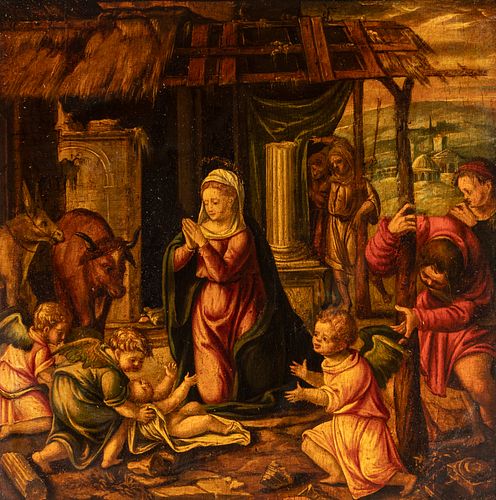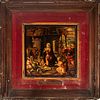Spanish school of the first half of the XVII century. "Nativity. Oil on panel.
Lot 23
About Seller
Setdart Auction House
Carrer Aragó 346
Barcelona
Spain
Setdart Subastas was born in 2004 and is currently the first online art auction in Spain with solidity, prestige and reliability guaranteed by our more than 60,000 users. Setdart has a young, dynamic and enterprising team ready to successfully manage the purchase and sale of art works through custom...Read more
Estimate:
EUR€1,200 - EUR€1,500
$1,290.32 - $1,612.90
Absentee vs Live bid
Two ways to bid:
- Leave a max absentee bid and the platform will bid on your behalf up to your maximum bid during the live auction.
- Bid live during the auction and your bids will be submitted real-time to the auctioneer.
Bid Increments
| Price | Bid Increment |
|---|---|
| EUR€0 | EUR€10 |
| EUR€200 | EUR€25 |
| EUR€500 | EUR€50 |
| EUR€1,000 | EUR€100 |
| EUR€3,000 | EUR€200 |
| EUR€5,000 | EUR€500 |
| EUR€10,000 | EUR€1,000 |
| EUR€20,000 | EUR€2,000 |
| EUR€50,000 | EUR€5,000 |
About Auction
By Setdart Auction House
Oct 20, 2021
Set Reminder
2021-10-20 07:30:00
2021-10-20 07:30:00
America/New_York
Bidsquare
Bidsquare : OLD MASTERS
https://www.bidsquare.com/auctions/setdart-auction-house/old-masters-7700
Setdart Auction House sofia@setdart.com
Setdart Auction House sofia@setdart.com
- Lot Description
Spanish school of the first half of the XVII century. "Nativity. Oil on panel. Size: 27 x 27 cm; 48,5 x 48,5 cm. In this variegated panel, the artist shows the Child Jesus on the ground, completely naked and assisted by little angels. This iconography is based on the Revelations of Saint Bridget of Sweden, from the 14th century, who in one of her visions, includes the description of the moment of childbirth given to her by the Virgin herself. According to this vision, when Mary knelt down to pray, she felt the Child move inside her, whom she immediately gave birth to. Without changing her position, the Virgin began to adore the Child with the utmost decorum and reverence, and was joined shortly afterwards by angels. Meanwhile, St. Joseph had gone out to look for something to light the place and did not attend the birth. Also participating in the scene are the ox and the mule, omnipresent in our traditional Nativity scenes, which, however, are not mentioned in the accounts of the Birth of Christ given in the canonical Gospels. The Gospel of St. Luke tells that St. Joseph and the Virgin Mary went to Bethlehem to register following a census ordered by Rome and adds: "And it came to pass, while they were there, that the days of childbirth were fulfilled, and she gave birth to her firstborn son, wrapped him in swaddling clothes and laid him in a manger, because they had no room in the inn. Some apocryphal gospels, such as the Protoevangelium of James or the Pseudo-Matthew, refer to the place of birth as a grotto or cave, plunged in darkness, a motif that will appear frequently in Byzantine art and is also maintained in traditional nativity scenes. In Western art, on the other hand, the motif of the grotto is rare. Based on accounts such as that of The Golden Legend of Jacobus of Voragine, from the 13th century, the scene is usually located in a stable or shed, as in the present panel, generally in ruins and semi-abandoned, which was used as a shelter or resting place by both people and animals.
- Shipping Info
-
In-house shipping available. Please inquire at admin@setdart.com.
-
- Buyer's Premium



 EUR
EUR CAD
CAD AUD
AUD GBP
GBP MXN
MXN HKD
HKD CNY
CNY MYR
MYR SEK
SEK SGD
SGD CHF
CHF THB
THB







